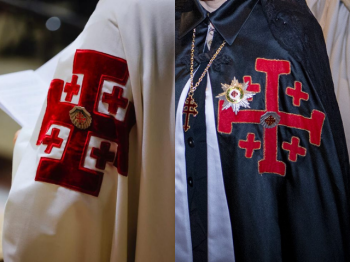The cloak, a luminous sign of our identity

We live in a world of symbols. We must be careful we know how to interpret them, not limiting ourselves to their external appearance, however striking and solemn it may be, but delving into their meaning, searching for the transcendent. We must, in a word, flee the danger of being dazzled by the external aspects in order to enjoy a more luminous and revealing dimension: let us therefore try to look at symbols with the eyes of the soul and heart.
Let us consider our main symbol, the cloak. As in the Revelation of St. John (Rev. 7:2- 4,9-14) someone might ask, “These who are clothed in white, who are they and where did they come from?” Are we able to answer “They are those who have washed their robes, making them white in the blood of the Lamb”?
Indeed, the cloak of our Order, which we receive on the altar at the moment of Investiture, should invite us never to be satisfied with the aesthetic enjoyment of its contemplation, but to seek a deep understanding of its meaning.
What is its meaning?
For a Knight, wearing a cloak invokes an obligation to loyalty, obedience, respect, honor discipline, sacrifice, responsibility, solidarity, to name but a few chivalric virtues. The recipient must live up to these virtues and wear it with dignity. For a Knight of the Order of the Holy Sepulchre, the whiteness of whose cloak reveals the Jerusalem Cross commemorating the five wounds of Our Lord, it also means something more.
For Dames, the black cloak, possibly embellished with white gloves and satin linings (as is the tradition in some countries) and surmounted by a lace veil or mantilla, highlights femininity with understated elegance. St. Paul reminds us that as baptized we are “clothed in Christ” (Gal 3:27). And that is what we are to feel as we wear our cloaks with the Jerusalem Cross, reminding us of the white robe of Baptism.
I tremble to remember that terrible invective of Jesus: “Woe to you, scribes and Pharisees, hypocrites! For you are like whitewashed tombs which on the outside appear beautiful, but inside they are full of dead men’s bones and all uncleanness” (Mt. 23:27).
Those who glory in their garments out of vanity are wrong, but so are those who detect a contradiction between the splendor of the cloak and the humility recommended for every Christian. Indeed, one can wear a brilliant uniform with humility and on the contrary be haughty in a shabby dress. So, we should not be prevented from admiring the beauty of the cloak. Our Lord was also transfigured on Mount Tabor.
Therefore, the cloaks we wear should not only remind us of what we represent, but also help us to transform ourselves into authentic Knights and Dames who have in the Empty Tomb, and therefore in the mystery of Christ’s Resurrection from the Tomb, the ideal reference of their commitment. Let them be, on the one hand, the shining sign of our dignity as a risen people and, on the other, the reflection of what we carry in our hearts, aware that their symbolic power achieves its purpose in the total identification between the suit and the wearer.
(March 2024)



